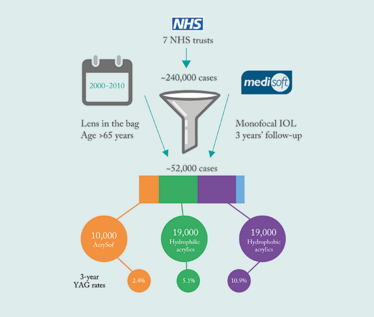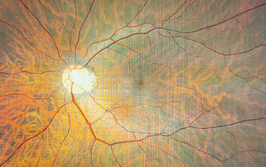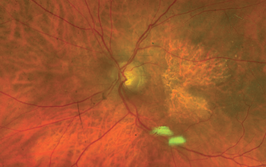Polymers and PCO: the IOL Material Lowdown
When you have a big dataset, what was once suspected can now be confirmed
Some doctors view electronic medical records (EMR) systems simply as “admin” that gets in the way of interacting with their patient rather than actually helping them. Sometimes it helps to see the value of EMRs by stepping back and looking at the bigger picture. When you have comprehensive, high-quality real-world data available, it enables faint suspicions and “hints of a signal” to be tied down and defined as fact or fallacy. And that’s exactly what Ursell and colleagues have managed to do with a three-year retrospective database analysis of YAG laser capsulotomy rates for the treatment of posterior capsular opacification (PCO) following cataract surgery that involved seven NHS trusts in the UK (1).
“PCO is something that happens a few years after surgery and it’s thought to be related to the IOL polymer. We wanted to see whether this was the case with real-world data,” explains consultant ophthalmic surgeon and first author of the study, Paul Ursell. “[The Medisoft database] is a comprehensive patient record of everything that happens at biometry, vision, surgery, IOL. When the patient comes back to the clinic again, the same data is recorded – and it also records when they had a YAG laser to treat PCO.”
“One of the problems with retrospective analysis of databases has been whether the patient actually did come back to you (and didn’t go somewhere else for the YAG laser procedure) – and whether it was recorded,” says Ursell. The group got around this problem by looking for UK hospitals that 1) used the Medisoft database, and 2) were the only people in the region with a YAG laser – “If a patient did develop PCO, they came back to the same hospital for treatment, rather than leaking out to other units.” The team found seven units in the UK and obtained all of their data from 2000 to 2010 – 240,000 thousand cases in all. The cases examined were restricted to monofocal IOLs placed in the bag with three years’ worth of follow-up in patients aged over 65 years. “That whittled it down to 52,000 cases. Of that, we had 10,000 AcrySof, 19,000 hydrophilic acrylic, and about 19,000 hydrophobic acrylic IOLs in there.” But what did they find?

Figure 1. Study design and key results from Ursell et al.’s three-year retrospective database analysis of YAG laser capsulotomy rates for the treatment of PCO following cataract surgery. The main influence on PCO rates was the IOL biomaterial.
“When we looked at three years’ worth of data, patients receiving AcrySof lenses had a 2.4 percent chance of a YAG laser capsulotomy, hydrophobic acrylics had a 4 percent chance, and hydrophilic acrylics, a 10.9 percent chance. This shows that the overwhelming factor influencing whether a patient having YAG after surgery is the IOL biomaterial.” Ursell adds, “There were some other incidental findings: complications during surgery increases the chance of undergoing YAG laser capsulotomy (but in very low numbers). We removed patients under the age of 65 years – but age hardly had any effect at all, which I was very surprised about.” The take-home message? “The main thing affecting PCO after cataract surgery is the IOL polymer biomaterial and AcrySof seems to perform better than hydrophobic acrylics and certain hydrophilic acrylics,” concludes Ursell.
Paul Ursell discusses his presentation of "A multicentre, retrospective cohort study comparing the real-world incidence of Nd:YAG laser capsulotomy procedure to treat posterior capsular opacification in the first 3 years after cataract surgery among hydrophobic and hydrophilic acrylic
- P. Ursell et al., “A multicentre, retrospective cohort study comparing the real-world incidence of Nd:YAG laser capsulotomy procedure to treat posterior capsular opacification in the first 3 years after cataract surgery among hydrophobic and hydrophilic acrylic IOLs”, Presented at the Cataract Surgery Practice Styles/PCO session at the 35th Congress of the ESCRS, Lisbon, October 10th, 2017.
I spent seven years as a medical writer, writing primary and review manuscripts, congress presentations and marketing materials for numerous – and mostly German – pharmaceutical companies. Prior to my adventures in medical communications, I was a Wellcome Trust PhD student at the University of Edinburgh.













